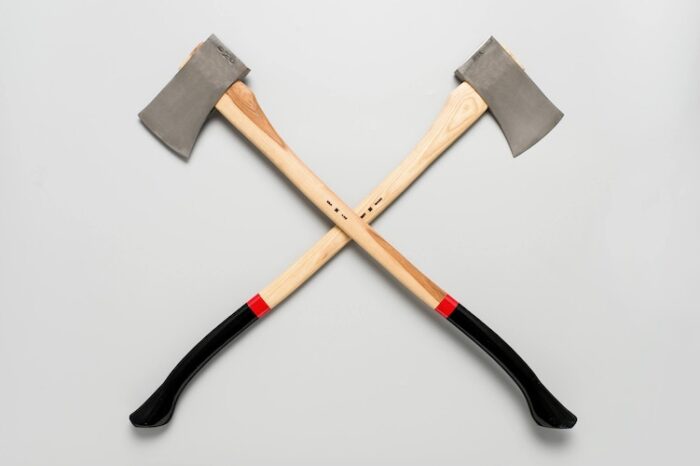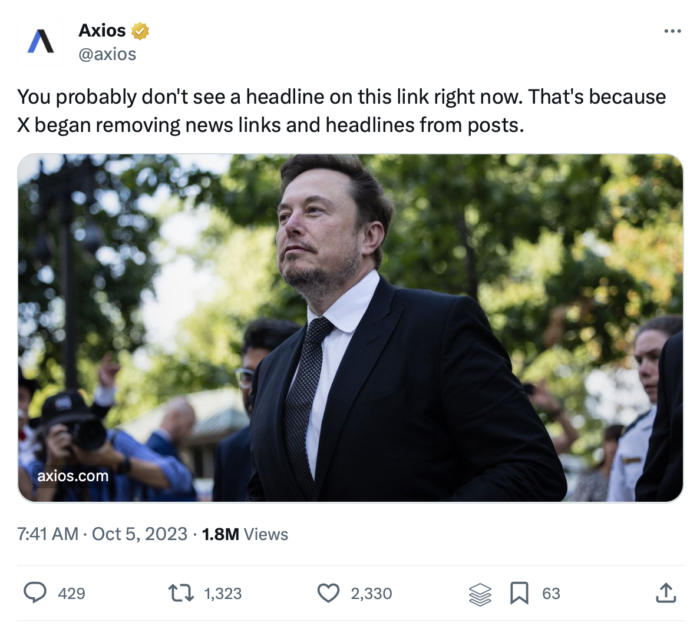
The saga of how Elon Musk has undermined news on X (RIP Twitter) in the year since his chaotic evil takeover of the company is a long one. Swapping verification for pay-to-play system Twitter Blue1 ; labeling NPR “state-affiliated media”; and throttling the (already-limited) flow of traffic to news websites from links posted on the platform, to name a few standout moments.
But if you had to come up with a single move designed to deal a blow to whatever traffic is left and make sharing news more of a hassle, you couldn’t do much better than eliminating headlines from posts, which Musk did on Wednesday. Here’s what that looks like for news stories:

Here’s what that same tweet would have looked like before the change. (For some reason, embedded tweets still show headlines, at least for now.)
You probably don’t see a headline on this link right now. That’s because X began removing news links and headlines from posts.https://t.co/fEMApfR6AD
— Axios (@axios) October 5, 2023
This change has been in the works since at least August, so it wasn’t a complete surprise. According to legacy news lover Musk, removing headlines “greatly improves the esthetics [sic].” Aside from headlines being the tools that reporters and editors craft explicitly as hooks to try to get a reader to click, with these textless images, news stories basically look like…memes? As reporters and non-reporters alike have demonstrated:
when you write stories like this, of course you want it to have an impact—but this was certainly an unexpected outcome
(see for yourself: search this link on twitter https://t.co/QWSA3UroEi) https://t.co/c2J1ES9xtn
— Kylie Robison (@kyliebytes) October 5, 2023
Obviously not happy with the change to how links are displayed. My prediction is that Twitter is going to become a place for just jokes and cultural arguments and chasing clout, and posting memes, and shitposting, instead of a destination for news discovery and analysis.
— Joe Weisenthal (@TheStalwart) October 5, 2023
Don’t think Twitter fully thought through the consequences of this change pic.twitter.com/JQZwEYkeuZ
— Aidan McLaughlin (@aidnmclaughlin) October 5, 2023
Could a change that allows you to share a link with a headline you make up based on a photo and zero context help spread…….misinformation? Surely not, since here on the internet in 2023 we all live a totally organic and truth–fueled lifestyle, especially on TwitterX…
🚨Here’s a 🔥example of the kind of fake news trafficking that will explode because of @elonmusk @lindayaX disastrous decision to censor real news titles @doctorow — whether for satire or malicious intent, mis- and disinformation apocalypse on Twitter X.0🌊💩 https://t.co/todb4QtNDc
— jim haigh (@jmhaigh) October 5, 2023
Anyway, another view out there — maybe eliminating headlines will, ironically, make people more likely to click, because they want to know what the story is about and have nothing to work off except a mystery image:
in elon’s eternal wisdom, he’s decided that removing everything but the image from link previews will keep people from clicking and thus leaving twitter
in reality i’m now much more likely to click the link since i have to go there to see what i once could get from the preview
— Molly White (@molly0xFFF) October 5, 2023
This change might not be that hard for news outlets to work around. This morning, for instance, our own Josh Benton built a system for Nieman Lab that allows us to convert a headline, deck, and visual to a single image and post that in a tweet. It looks like this:
ICYMI, I wrote about how (possible!) new competition in the search market might affect the news industry.https://t.co/Hpu60YtWe3 pic.twitter.com/jjBN3mNLQb
— Joshua Benton (@jbenton) October 5, 2023
You can also just use a social-specific visual, similar to what many reporters already use if posting stories on Instagram, or an article screenshot, which is what many reporters already share on X anyway:
“The hardest-hit group? Local shows covering a single team.”https://t.co/5B6UgJzSO2 pic.twitter.com/D4fINdEePD
— Laura Hazard Owen (@laurahazardowen) October 5, 2023
Users will now write tweets differently to incorporate headline + source info https://t.co/32x8eWnji7
— Brian Stelter (@brianstelter) October 4, 2023
A former NBA player dies young, and AI writes this headline:
“Brandon Hunter useless at 42”
And check that prose:
“Former NBA participant Brandon Hunter who beforehand performed for the Boston Celtics and Orlando Magic, has handed away on the age of 42.” https://t.co/xEvVVHo9DP pic.twitter.com/EiKlZEhluS
— Joshua Benton (@jbenton) September 14, 2023
It also looks as if the change, for now, has some loopholes that don’t require workarounds. When you post links without a featured image, the headline still shows up:
The Messenger signs a deal to “eliminate bias” and flag “clickbait” with AI https://t.co/2coiTnQKB4
— Nieman Lab (@NiemanLab) October 4, 2023
For a lot of users, the change will probably be, above all, annoying, and one more blow to eX-Twitter’s utility — one more obstacle to sharing or skimming the kind of quick information bites that drew people to the platform in the first place.
You probably can’t see the headline here but it’s an article about why you can no longer see headlines on Twitter. My condolences to all the social media managers who now have to work around Elon’s latest ingenius plan to make the site less functional. https://t.co/YXuDNl6AfC
— Katie Herzog (@kittypurrzog) October 5, 2023
Dumbest thing @elonmusk has done here. And the one that really destroys core functionality for millions of users. This isn’t about politics. It’s about product. And the product is now much, much worse. https://t.co/2Wi4bY7idy
— Dan Primack (@danprimack) October 5, 2023
“In my opinion, removing headlines makes X harder to use — posts are less easy to parse at a glance — so I’m not sure if this change is going to lead to people posting more often like Musk hopes.”https://t.co/IlqLmOtdFp
— Pieter Friedrich (@FriedrichPieter) October 5, 2023
i love clicking on a stock Getty image and having no clue what the article is going to be about, great job https://t.co/vYpw9aYgIZ
— rat king 🐀 (@MikeIsaac) October 4, 2023
Will this latest bruh moment be enough to drive the media world off the platform for good, finally? Honestly, probably not. We’re too addicted as an industry and no one alternative has taken off enough to feed the beast of that addiction in the same way…but as just one more wound in the tragicomedy of Twitter’s death by a thousand cuts, pretty soon there won’t be any useful features left to sabotage.
I do wonder – given the lates changes detrimental to news – why some news organizations are continuing to pay to promote Tweets on here
— emily bell (@emilybell) October 5, 2023